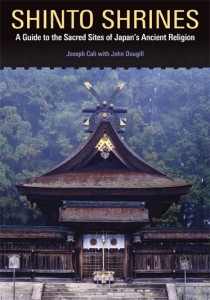 Joseph Cali is the main author of the forthcoming title, Shinto Shrines. (Publication date: Nov. 30, 2012. For further details and orders, please click here.)
Joseph Cali is the main author of the forthcoming title, Shinto Shrines. (Publication date: Nov. 30, 2012. For further details and orders, please click here.)
1) When and why did you first conceive of the book?
When I first began working on The New Zen Garden around 2002. At that time, I met an exceptional gardener named Yasumoro Sadao who taught me about traditional garden design. Although the theme of the book was modern dry-gardens (karesansui) and especially the influence of Buddhism, Yasumoro sensei (and a number of other gardeners) loved to say that Buddhism had nothing to do with garden design. But a comment he made to me about ‘listening to the kami of the place before starting to work’ stayed with me. I think this and Landon Warner’s Enduring Arts of Japan put Shinto on the playing field for me.
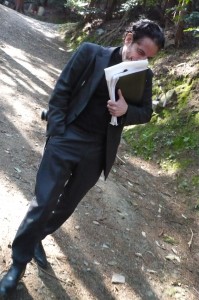
2) How did you go about selecting the 57 shrines included in the book?
Well, the original intention was to have about 100 shrines. I used my basic knowledge of the country and listed up all the major shrines. Then I began area searches focusing on major historic cities such as Nara and Kyoto, and then island by island beginning with Kyushu. I also searched endless lists of ‘favorites’ and ‘top 5’ and any shrine that was mentioned as interesting — the Shinto ML list was helpful here.
3) How did you carry out the research?
Once I had composed a list I set about finding someone to help with the research. When I had as much information about a shrine as I could find, I wrote it up and then began sending out letters to shrines. The letters included information about the book, the contents of the entries, a request for photos that could be used in the book, and then slowly arranging for meetings with an official from the shrine. I spent between one and four hours with priests to verify key points, and another one to three hours wandering the shrine grounds and photographing.
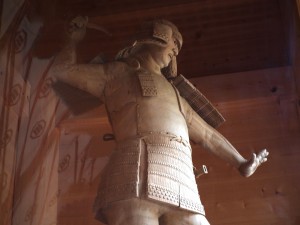
A fascinating and unique zuijin guardian figure in the new romon of Oyamatsumi Jinja in the Seto Inland Sea. An interesting combination of zuijin and nio Buddhist guardians, sheathed in 13th century armor.
4) What were the main difficulties you encountered?
The only difficulty I encountered was the occasional reluctance to grant me the use of photos or of an interview. However this was not usually very difficult to overcome. In some cases I had to go back again and again before getting an OK. However you come to realize that part of it lies in the layers of organization (particularly in some of the larger shrines) and partly what I perceive as a great fear of creating any sort of controversy or taking responsibility for having said something which may cause damage to the shrine. Once people could see that I had a good grasp of their concerns and were convinced of my non-political intentions, there was little difficulty.
The other problem was one of my own making. My initial goal of one hundred shrines proved impossible in terms of pages. When I had more or less completed eighty-eight shrines, I sent it off to the publisher whose initial reaction was that 50% needed to be cut! With some finessing of the layout, I managed to retain 57 shrines but had to out the remaining ones, not to mention a big chunk of the background material on Shinto. I believe I managed to retain most of the major shrines and several smaller shrines that will be of interest to those involved with Japanese arts such as aikido, bugaku, and Noh.
The other major problem was that my long-time publisher, Kodansha International, decided to close their doors in April of 2012—roughly one month after the Great East Japan Earthquake — just as the book was on the layout table. This set the project back more than a year but in the end enhanced the quality, as the new publisher, University of Hawaii Press, has produced an even better version than the original.
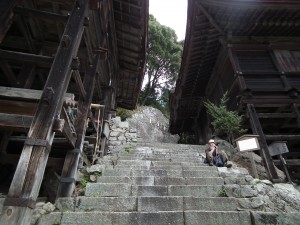
The “golden rock” at the Hachioji Jinja of Hiyoshi Taisha in Shiga Prefecture. Thought to be the place where worship on Mt. Hie began, it is situated between the Sannomiyagu and the Ushiogu on top of the 1,200-foot hill.
5) What impressed you the most in compiling the information?
I would say that while I am a lover of traditional architecture (and there is plenty of that in the book), I am always most impressed by people. Although this was not the focus of the book, I think it was the extraordinary kindness of the priests I met which impressed me the most. For example, I thought I had lost my camera on the way to Kifune Jinja outside Kyoto. I had had a meeting with a priest at Heian Jingu, and as I got off the train at Kurama and reached for my camera it had gone! When I finally got to Kifune shrine and announced my name, I head a voice call from the back, ‘Cali san, your camera is here!’ All the miko and priests in the shrine office began to laugh at the look of confusion on my face. It turned out that I had left my camera at Heian Jingu, and the priest there, knowing I was on my way to Kifune, jumped on a train. Since I had taken the long route, he had already delivered it before I got there. This incredible act of kindness was repeated in different form on more than one occasion.
6) What kind of readership do you think the book will appeal to?
Certainly anyone interested in visiting a Shinto shrine. Shrines are not the most accessible places and it is very easy to come away nonplussed. This book will help to make it a more fulfilling experience. I think people interested in Japanese culture generally will also benefit, for it strikes me how much I have learned about Japan from books like Karen Smyer’s The Fox and the Jewel about Fushimi Inari Shrine, or from John Nelson’s A Year in the Life of a Shinto Shrine about Nagasaki Suwa Shrine.
I hope my book will also appeal to people planning their itinerary for a visit to Japan, as well as those who may not have the opportunity to visit but are interested in the country’s religion and its places of worship. It may also be a good resource book from which to launch further study. With all the spurious information out there on the internet, I think it will be very helpful to have a single source of reliable information that does not cost hundreds of dollars, as many of the scholarly resources on the subject do.
***********
To see Joseph’s excellent blog on Shinto Shrines, please click here.
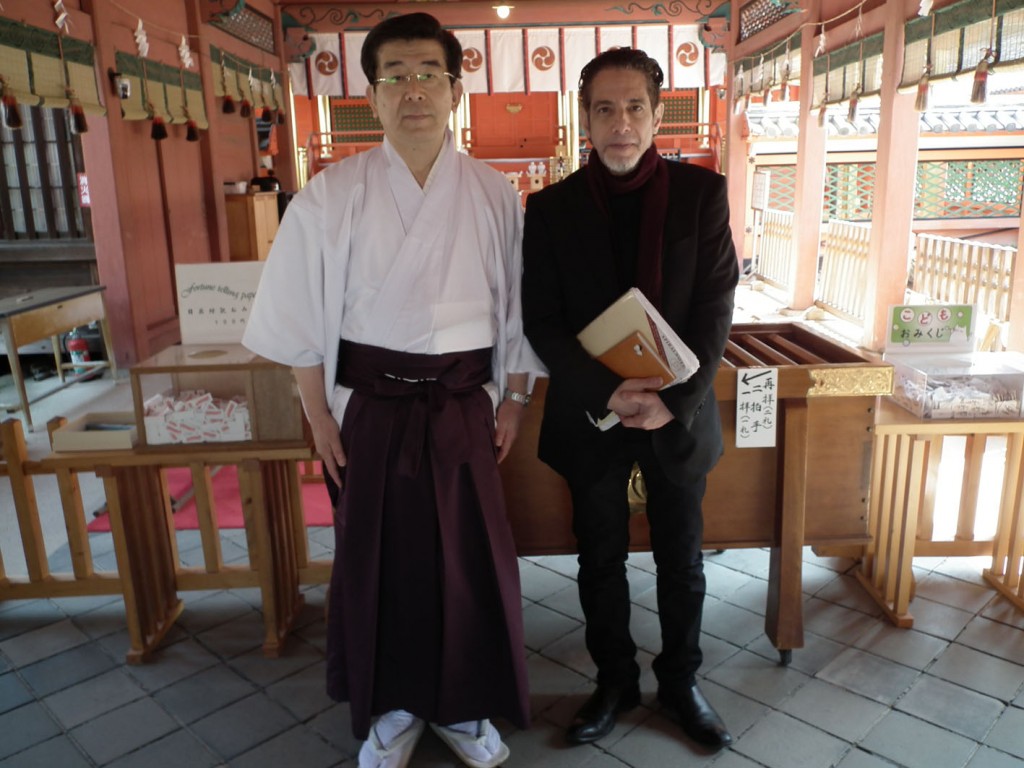
With Noguchi Guji of Isaniwa Jinja in Matsuyama, which according to Joseph is one of the finest examples of Hachiman style in Japan

congrats on the release of the book